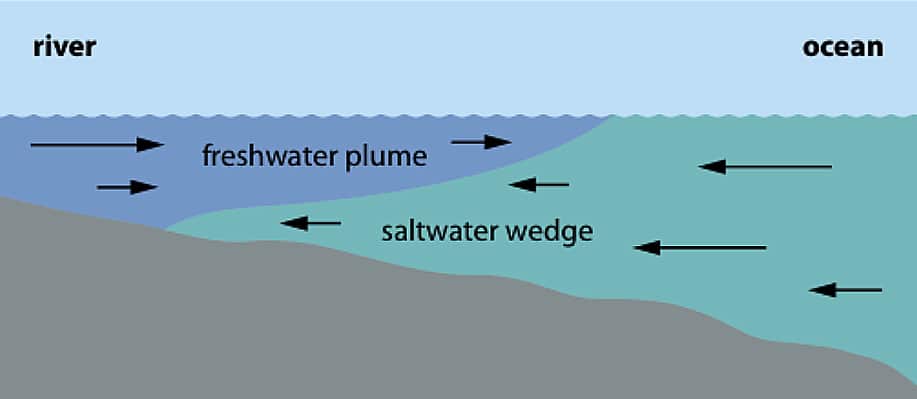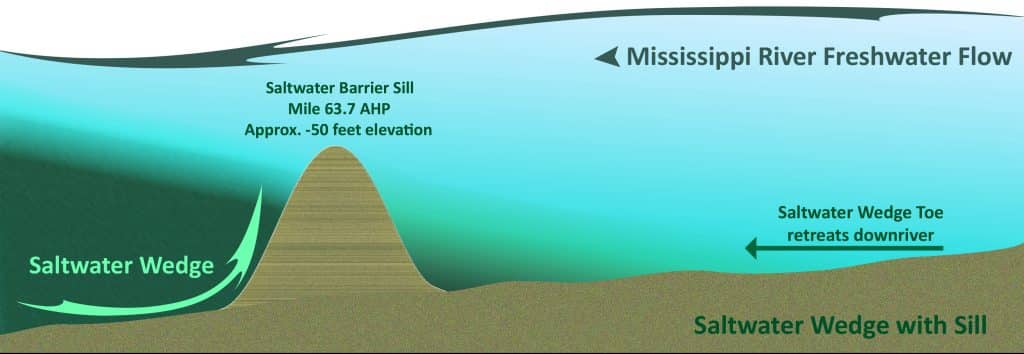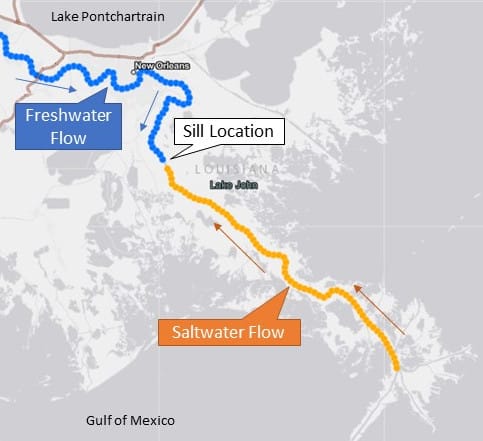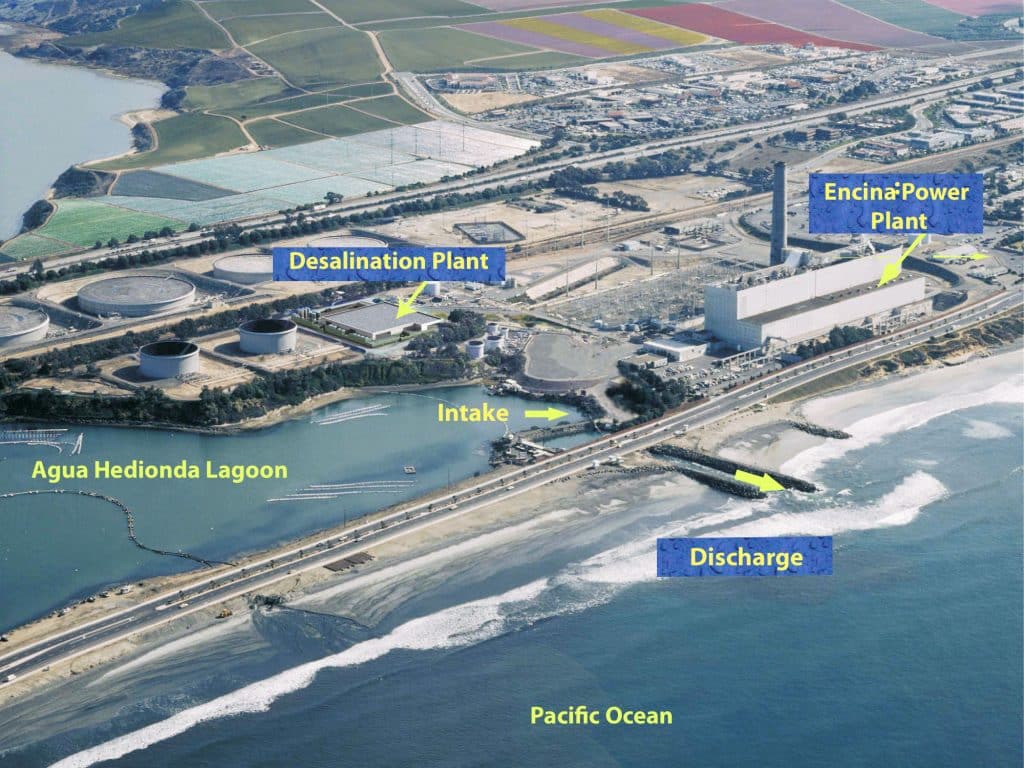
Since this past summer, saltwater has been slowly moving up the Mississippi River from the ocean in a natural process known as saltwater intrusion, appearing in drinking water of local residents. With a major city, New Orleans, just miles upstream, officials are racing to avert a large-scale water crisis, though progress has been tardy. In this article, we take a look at how this crisis arose and what can be done to contain it as well as avoid similar events from happening in the future.
—
Saltwater has been invading the Mississippi River from the Gulf of Mexico over recent months, posing a major threat to public health in the New Orleans area. This summer, residents in the river delta basin region south of New Orleans began to notice saltwater in their tap water and pipes. The issue persisted for months, making national headlines and prompting state and federal declarations of emergency.
The Mississippi River – the second-longest river in the United States – runs across nearly the entire north-to-south length of the country, passing through ten states before flowing into the Gulf of Mexico through Southeast Louisiana. The river’s massive size is typically sustained by substantial yearly rainfall across the middle of the country, as well as waters from its tributary rivers like the Ohio and Missouri rivers. When at its normal levels, the river water can pass undeterred all the way to the Gulf of Mexico. Yet raging droughts over the last year have seen water levels fall drastically (in fact they fell so much that a 1915 shipwreck of a trade vessel was discovered in shallow waters last year).
Without the river sustaining its high mass and velocity, saltwater from the Gulf of Mexico has been able to start pushing upstream in a process known as saltwater intrusion.
What Is Saltwater Intrusion?
Far underground, water permeates the ground beneath an concealed line called the water table. At levels this deep, the water saturation is dense enough that water can easily be drawn from the ground via springs or wells. These regions of the underground are called aquifers, and they make up the immense majority of the global freshwater supply.
Saltwater intrusion occurs when saltwater from the ocean slowly moves into and occupies space in freshwater systems like rivers and aquifers. While the ground layers beneath the land are usually full of fresh water, the ground beneath the oceans is salty. When these underground freshwater and saltwater layers meet, they push against each other, and this is where saltwater intrusion can occur.
Since saltwater is far denser than freshwater, it usually exerts greater pressure and naturally encroaches inland. This process can be further accelerated when the freshwater levels in the ground deplete, often a consequence of aquifer over-pumping or river dredging, as well as climate-caused factors like droughts and sea level rise.
Graphic of coastal saltwater intrusion. Image: California Water Science Center.
Rivers pose a unique risk as they allow a way for saltwater to reach areas further inland, which is what is happening in the Mississippi River.
Because of an extreme lack of rainfall in the midwestern and southern US, the Mississippi River’s volume has dropped significantly. In fact, the river reached record low levels just last year. In addition, sea levels around Louisiana have been steadily rising at a rate of one inch (2.54 cm) every two years since 1950. These two factors craft the perfect setting for saltwater intrusion, as the river no longer has its usual mass to force the saltwater back as it empties into the Gulf of Mexico.
Saltwater wedge moving in a river. Image: Yale Environment 360.
Saltwater is then slowly able to force its way upstream along the very bottom of the river in what is known as a saltwater “wedge.” As it travels up the river, it acquires ready access to infiltrate inland aquifers and seep into community water systems.
What Are the Dangers of Saltwater Intrusion?
When consumed, saltwater can have earnest adverse effects on the body. The system is put at major risk, and resulting complications (like hypertension) can lead to more critical issues like heart attacks and strokes. Other bodily systems are at risk too, such as the kidneys, digestive system, and even skin defects, which can arise from washing clothes or showering with salt-contaminated water.
Saltwater intrusion also has a negative impact on local biodiversity and the environment. As saltwater penetrates rivers and aquifers, it introduces salinity levels far too high for many plant and animal species to survive in. Vegetation is crippled and many animal habitats are disturbed, leading to the displacement and disruption of balanced food chains.
It is not just the local area of the intrusion that is affected. Saltwater can significantly contribute to greenhouse gas emissions through its accelerated decomposition of peat, a natural material that sequesters carbon in high concentrations. As peat decomposes, carbon is released into the atmosphere. This contributes to rising temperatures and climate events like droughts and sea level increases, which are the prime conditions for more saltwater intrusion to occur.
Lead pipes were frequently used in the first of the 20th century to build up public and private water systems, though they are now of course widely known to pose a major risk to public health. Saltwater is much more corrosive than freshwater and, when it gets into water systems, it can easily corrode lead pipes, which leeches toxic substances into drinking water. New Orleans, like many other cities, does not even know exactly where all of its lead pipe infrastructure is located across the city.
In 2021, the Biden administration pushed congress to pass the Bipartisan Infrastructure Law, and a major portion of that law aims to replace all lead pipes in the country within the next decade. Billions of dollars are packed into the law in hopes to revitalize and modernize the country’ infrastructure. However, it is a race against the clock, as saltwater waits for no one and the public’s health is at stake.
How Are Officials Addressing the Situation?
The US Army Corps has carried millions of gallons of fresh water to affected communities via barge, blending it with the river to reduce the salt content and freshen the water in treatment plants. Plans have also been put in place by a few municipal areas to construct pipelines to import freshwater from sources further inland.
New Orleans had a $200 million pipeline planned for construction, but these plans have been tabled for now as the saltwater’s progress has significantly slowed in recent weeks. Efforts like these provide immediate relief to affected areas but they are quite steep and only short-lived solutions, and can contribute to the problem in the long run by over-pumping water in other areas.
A major construction technique employed by the US Army Corps of Engineers is to prevent (or at least tardy down) saltwater intrusion by constructing water sills on the river floor. These are ground barriers (think underwater levees), designed to impede the saltwater wedge progressing upstream along the bottom of the river.
Before this year, sills had been built four other times in the Mississippi River, in 1988, 1999, 2012, and 2022. However, this year the saltwater progression has been so mighty that it overtopped last year’s sill construction. Alterations have since been made to strengthen them against the progression of the salt, a move that has, so far, been successful in keeping the saltwater from reaching New Orleans.
Underwater sill. Image: US Army Corps of Engineer
Also helping tardy the progression are immense natural holes along the bottom of the river, for the extremely dense saltwater must fill these holes before progressing further upstream.
Map of sill location in the Mississippi River. Image: US Army Corps of Engineer
Is it Possible to Remove the Salt From Saltwater?
Desalination is another possible, yet controversial, solution to saltwater crises. There are a variety of methods that remove salt from water, the most common form being solar desalination, where saltwater evaporates and then later falls back to the earth as rain.
Apart from this natural process, humans have developed a few mechanistic techniques to generate freshwater from saltwater. The first large-scale evaporator was built in Kuwait in 1951, and since then, the technology has advanced, resulting in the increased construction of desalination plants all over the world, especially over the last two decades.
Desalination is most commonly used in the Arabian Peninsula, nearly 6 billion gallons of saltwater are pumped from the ocean each day to meet a majority of the countries’ freshwater demand. The US is in the process of constructing more and more desalination plants, though often to significant public backlash.
Carlsbad Desalination Plant in San Diego, the largest in the USA. Image: WCP.
Desalination plants are steep and energy intensive, consuming immense amounts of electricity and emitting carbon dioxide into the atmosphere at rates at the level of tens of thousands of cars. These plants also disturb local habitats and biodiversity, not just because their construction disrupts local species, but also because of their waste discharge.
The recovery ratio for desalinated water is unproductive, with only one liter of water produced for every 1.5 liters of its waste, a briny discharge. This discharge is not only extremely high in salt content, but it also contains chemicals like chlorine, copper, and other potentially toxic agents used in the desalination process.
There are a few different procedures to conduct desalination; some common forms are electrodialysis, evaporation, and reverse osmosis. Reverse osmosis filters are currently being deployed in water treatment plants in the affected Louisiana communities, and it appears desalination will continue to grow as a popular global freshwater solution. It is critical for governments and corporations to put more effort into regulating the technology so that it is deployed in the most neat, equitable, and effective way possible.
What Is the Outlook on the Situation?
Officials no longer expect New Orleans to be significantly impacted by the saltwater intrusion, however, a few more nearby parishes downstream do expect saltwater to penetrate their water supply by behind schedule November. While it looks like drastic consequences will be avoided in the immense metropolitan area of New Orleans, thousands of people have been and will continue to be impacted.
Questions have been raised regarding the amount of dredging that the Army Corps of Engineers has conducted in the Mississippi River over the last century. Over-pumping and dredging are known to create unstable conditions that lead to aquifer depletion and contamination, but economic priorities have seen public health risks ignored in the service of other goals. These ongoing events act as a forewarning to other coastal regions on the dangers of saltwater intrusion, which is far reaching throughout the country, but are also a reflection of the overall groundwater crisis impacting much of the world today. Responsible management of the nation’s water systems is critical moving forward, if crises like that in the Mississippi River are to be mitigated in the future.





